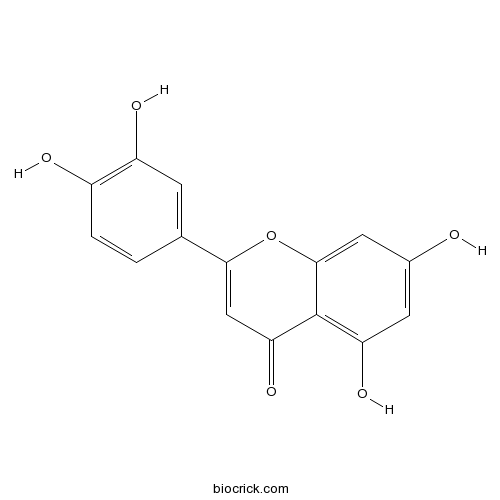Lonicera confusa
Lonicera confusa
1. The products in our compound library are selected from thousands of unique natural products; 2. It has the characteristics of diverse structure, diverse sources and wide coverage of activities; 3. Provide information on the activity of products from major journals, patents and research reports around the world, providing theoretical direction and research basis for further research and screening; 4. Free combination according to the type, source, target and disease of natural product; 5. The compound powder is placed in a covered tube and then discharged into a 10 x 10 cryostat; 6. Transport in ice pack or dry ice pack. Please store it at -20 °C as soon as possible after receiving the product, and use it as soon as possible after opening.
Natural products/compounds from Lonicera confusa
- Cat.No. Product Name CAS Number COA
-
BCN5600
Luteolin491-70-3
Instructions

[Analysis of critical genes expression of chlorogenic acid and luteolin biosyntheses in Lonicera confusa].[Pubmed: 25276965]
This study analysed the tissue specific expression of critical genes involved in chlorogenic acid and luteolin biosynthesis, for exploiting the molecular mechanism of components biosynthesis in Lonicera confusa. Expression of PAL, 4CL, C4H, CHS, CHI, FNS and HQT gene families of chlorogenic acid and luteolin biosynthesis-related genes in buds and leaves of L. confusa were analyed by Real-time PCR. Expressions of PAL1, C4H1, 4CL1, CHS1, CHI3 and HQT2 in buds were lower than that in leaves, and expressions of PAL3, 4CL2, CHI2 and FNS2 in buds were higher than that in leaves. The results indicated that that PAL3 and 4CL2 may be associated with accumulation of chlorogenic acid, and the expression patterns of PAL1, CHS1, CHI3 and HQT2 in buds and leaves of L. confusa were different with L. japonica. This study provided some theoretical basis for the further research on genetic mechanism of active components differences in L. confusa and L. japonica.
Characterization and molecular interpretation of the photosynthetic traits of Lonicera confusa in Karst environment.[Pubmed: 24959829]
Lonicera confusa was a medical plant which could adapt to the Ca-rich environment in the karst area of China. The photosynthesis, relative chlorophyll content,differentially expressed genes (DEGs) and differentially expressed proteins (DEPs) of L. confusa that cultivated in calcareous and sandstone soils were investigated. The results showed that the relative chlorophyll content and net photosynthesis rate of L. confusa in calcareous soil are much higher than that planted in sandstone soil, the higher content of calcium might play a role in keeping the chloroplast from harm and showed higher photosynthesis rate. The transpiration and stomata conductance were decreased in calcareous soil, which might result from the closure of stomata. The GeneFishing and proteomic results showed that the expression of DEGs and DEPs were critical for photosynthesis and stomata closure, such as RuBisCO, photosynthetic electron transfer c and malate dehydrogenase varied in the leaves of L. confusa that cultivated in different soils. These DEGs or DEPs were further found to be directly or indirectly regulated by calcium sensor proteins. This study enriched our knowledge of the molecular mechanism of high net photosynthesis rate and lower transpiration of L. confusa that cultivated in the calcareous soil in some degree.
[Study on the volatile oil of leaf of red gland Lonicera in guangxi].[Pubmed: 22260006]
To compare volatile oil of Lonicera confusa (red gland Lonicera) fresh leaves with dry leaves and provide evidence for further study of Lonicera confusa leaves.
[Genetic diversity of medicinal plant Lonicera confusa populations revealed by random amplified polymorphic DNA].[Pubmed: 19645229]
To analyze the genetic diversity and differentiation degree of five Lonicera confusa populations.
Determination of active constituents in Lonicera confusa DC. by capillary electrophoresis with amperometric detection.[Pubmed: 16799927]
A method based on capillary electrophoresis with amperometric detection has been developed for the determination of luteolin, chlorogenic acid, 3,5-dicaffeoylquinic acid and caffeic acid in the dried flower buds, leaves and stems (three medicinal parts) of Lonicera confusa DC., respectively. The effects of several important factors such as detection potential, the concentration of the running buffer, separation voltage and injection time were investigated to acquire the optimum conditions. The detection electrode was a 300 microm diameter carbon disc electrode at a working potential of + 0.90 V (vs saturated calomel electrode). The four analytes can be well separated within 10 min in a 40 cm-long fused silica capillary at a separation voltage of 12 kV in a 50 mM borate-25 mM phosphate buffer (pH 8.0). The relationship between peak current and analyte concentration was linear over about 3 orders of magnitude with detection limits (S/N = 3) ranging from 0.35 to 0.52 microM for all analytes. The proposed method has been successfully applied to the monitoring of bioactive constituents in the real plant samples with satisfactory assay results.
[Studies on chemical constituents in dried buds of Lonicera confusa].[Pubmed: 15575205]
To investigate the chemical constituents of the dried buds of Lonicera confusa.


